In this guide, I’ll explain the role of a sump pump, how they work, what to look out for, and where to buy them at the best rates!
Besides the obvious need and safety precaution, a sump pump brings to your home, you may actually be legally required to own and operate one.
The U.S. Federal Clean Water Act, passed in 1987, mandates sump pumps in homes that have even the slightest chance of being flooded, which is over 60% of homes America.
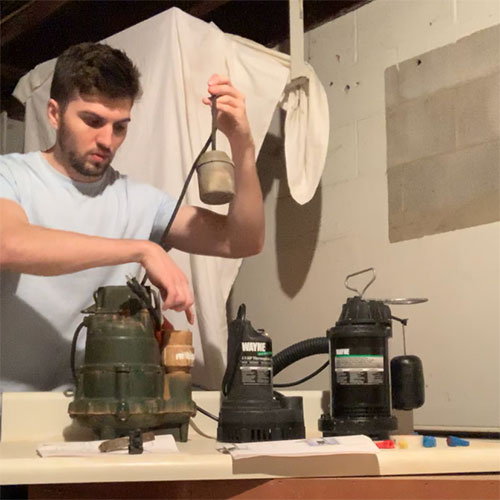
Let’s get your home legally cleared and water free, shall we? If you don’t know where to start or you want more general information about sump pumps, check out my buying guide below the list of products.
What's in this Guide?
Here Are the Best Sump Pumps (All Types)
1. Superior Pump Utility 91250
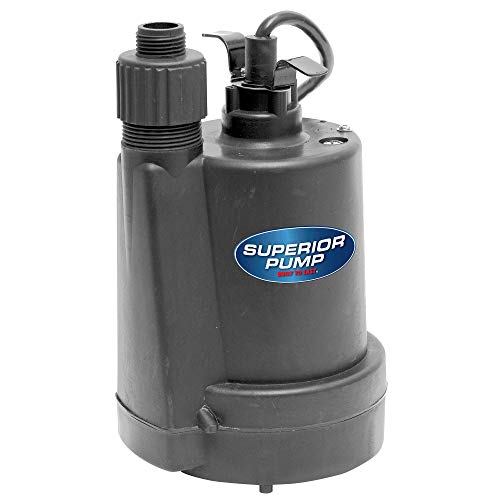
Price: Around $50
Type: Submersible electric pump – backup
Our Review: This grout sealer by The Floor Guys comes in a one-quart container and can be used on granite, marble, and slate safely. Ideal to be used on floors and in showers, this grout dries within 5 minutes thanks to its water-based formula. This grout dries clear so it will look at if it was never applied. In addition to this, the grout sealer can prevent water and oil stains on natural stone helping it to keep its original look.
This particular offering is more of a budget solution that works best for very small problems and spaces. Although cheap, it is incredibly tough and built to last and comes in a one-piece small form factor. A lot of people tend to use this pump for things, not sump pump related, however, it’s a good utility pump that’ll be useful in many different situations.
This does not have an automatic configuration and would only run when you manually plug it in.
I’d recommend buying their Superior Pump Universal Discharge Hose Kit along with it as its a good deal and ensures you’ll have a good fit and uniform system.
Key Features:
- 1/4 HP with 10-foot power cord plus split capacitor for increased power efficiency
- Constructed of a one-piece thermoplastic housing
- Jacketed stainless steel shaft seal and double sealed motor plate
2. ECO-FLO EFSA33 Cast Iron Sump Pump
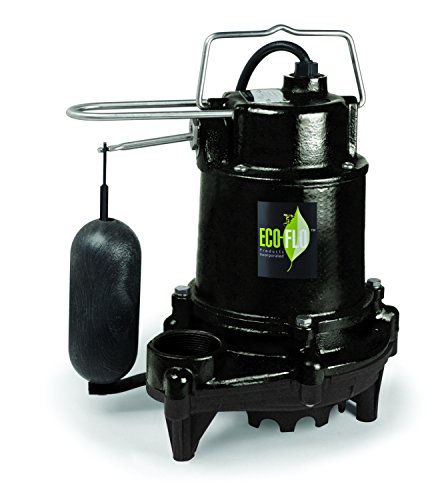
Price: Around $125
Type: Submersible vertical electric sump pump – primary
Our Review: This thing is built to last! It’s a cast iron construction making it extremely heavy, however, the cast iron allows for top class heat dissipation and extended durability. The float is constructed of polyoxymethylene (POM) plastic, which is widely known as one of the best materials used for these floats.
The sump pump runs nearly silent due to being encased in cast iron and the quality overall really stands out within this price range. You would be hard pressed to find another budget level pump that is more powerful and constructed as well as this one!
Key Features:
- 1/3 HP with Cast Iron construction with thermoplastic volute and anti-corrosion coating
- 11” vertical basin switch and Anti clogging vortex impeller design
- Permanent split capacitor for high electrical efficiency and Composite POM float rod with reinforced rib
3. Wayne CDU790
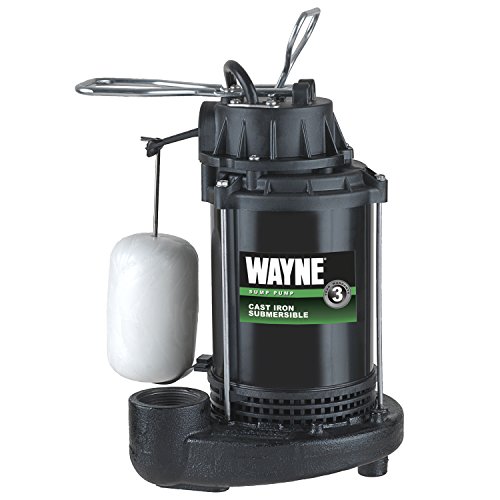
Price: Around $110
Type: Submersible vertical electric sump pump – primary
Our Review: Wayne is a long time brand with a very positive reputation in the world of pumps. They offer tons of different models for a very wide range of applications, so if this particular one doesn’t fit your needs flawlessly, you can explore their product catalog and I’m sure they have something that you’ll like.
This particular pump checks all the boxes for durability and is actually tested for over a million cycles. This pump should be more than enough for most people in the average size house. It runs nice and quiet and is probably one of the easiest sump pumps to set up ever to hit the market. At roughly a hundred bucks, this is a solid go to for most sump applications.
Key Features:
- ⅓ HP with cast iron encasement with steel vertical float
- Top suction design eliminates air lock issue
- Ceramic mechanical seals
4. Wayne WWB WaterBug
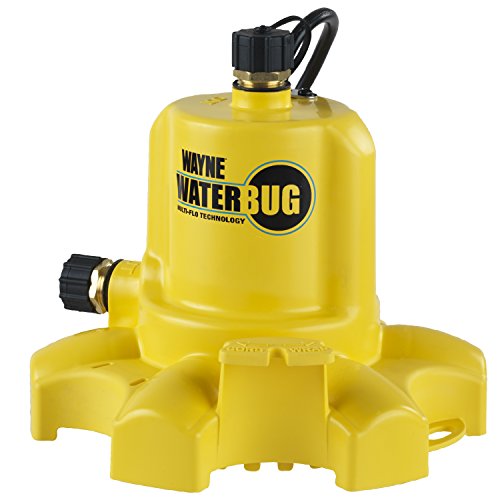
Price: Around $100
Type: Submersible vertical electric sump pump – backup
Our Review: The WaterBUG is a tiny pump that solves huge problems. Purpose-built to suck up water so low that most other pumps can’t get, this thing can pump over 1250 gallons an hour and connects to a standard garden hose. This probably isn’t the best primary permanent sump pump as it really isn’t designed for such an application and must be manually turned on, but it is one of my highest recommended back up pumps. At only $100, this thing offers an excellent level of peace of mind and a wide range of utility applications.
Key Features:
- ⅙ HP with super lightweight durable plastic construction
- Over 1250 gallons an hour and removes water down to 1/16”
- Usable with a standard garden hose
5. Liberty Pumps 237 Series
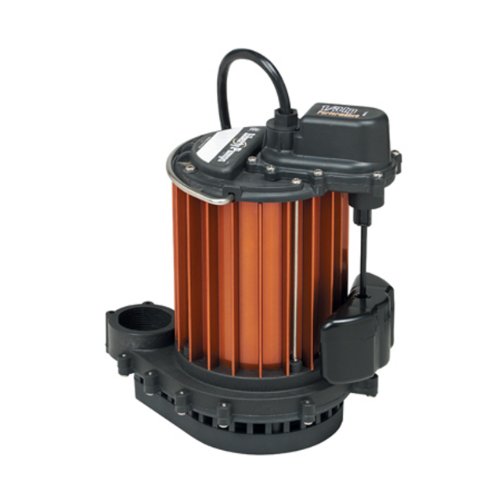
Price: Around $145
Type: Automatic Submersible electric powered – primary
Our Review: This little pump is great for small crawl spaces and averagely sized basements. It’s purpose-built for electrical efficiency and although it isn’t as powerful as most of the other primary sump pumps on this list, its a great deal and its perfect for those of you who want to install and forget. If your water problems are seldom and not drastic, you won’t need anything more powerful than this pump.
The construction is made up of powder coated aluminum and a polypropylene vortex style impeller. It’s not the most durable design ever created but it is among the most efficient and runs much cooler than most other similar sump pumps.
Key Features:
- ⅓ HP with 1.5” water discharge
- Magnetic VMF switch
- 10’ quick disconnect power cable
6. Zoeller M53 Mighty-Mate
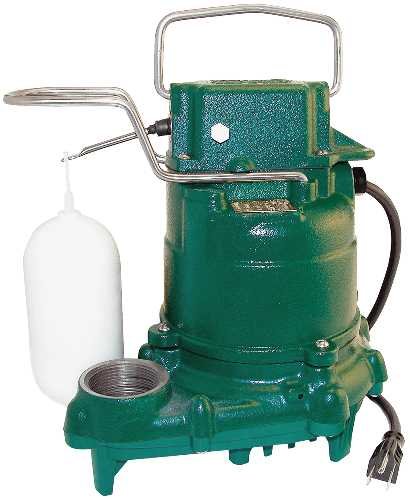
Price: Around $175
Type: Submersible automatic electric – primary
Our Review: Zoeller is another heavy hitter in the sump pump industry with a long-standing reputation based on their dependency and longevity. It isn’t the most efficient or most powerful unit you can buy, but it will get the job done for most average situations and since its got an automatic switch, you can install and forget. This particular pump is constructed of cast iron, which if you’ve read the other reviews you already know is a top design for durability and heat dissipation.
My only complaint here is the 9’ power cable, which doesn’t have a disconnect and is shorter than most of its competitors. If you don’t need any more than 9’, then this doesn’t matter!
Key Features:
- ⅓ HP with automatic float activating switch and a 9’ power cord
- Powder coated epoxy CI and SS fasteners
- Thermal overload protection
7. Wayne CDU980E
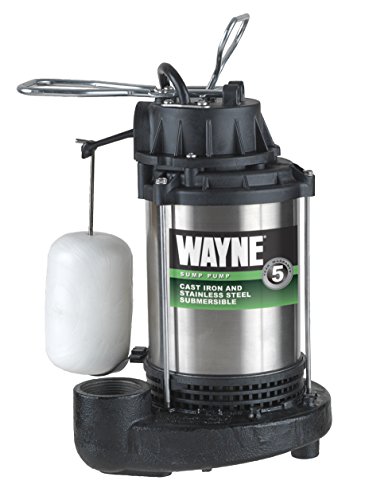
Price: Around $145
Type: Submersible verticle electric sump pump – primary
My Review: We discussed the smaller version of this, the CDU970 earlier in this review guide. These are essentially the same exact pumps with the only difference being the power levels. The 980E is significantly more powerful but only a little more expensive. This pump is ideal for people with large basements and a major water problem. Aside from that difference, the review on the 970 basically applies all the same to this pump. Wayne is a fantastic brand and both of these pumps work like a charm!
Key Features:
- ¾ HP Cast Iron Construction with stainless steel vertical float switch
- 8’ power cable
- Submersible in up to 8’ of water
8. Liberty Pumps Sj10 SumpJet
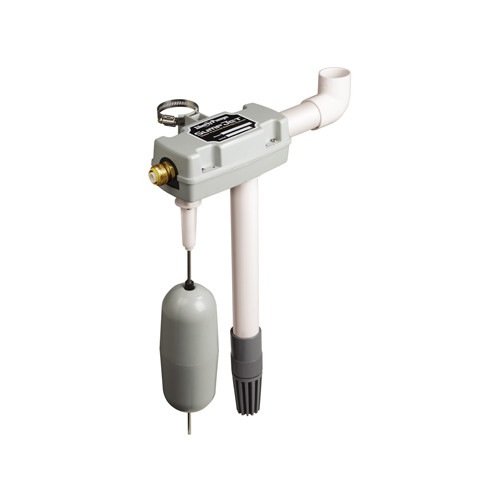
Price: Around $185
Type: Water powered backup pump
My Review: I briefly mentioned water powered sump pumps as a back up earlier in this guide. These really aren’t suitable for a primary application but they do shine brightly if your primary pumps electric power source is incapacitated. This little guy uses your homes municipal water source to create pressure and force the water under the pump out of your home. It’s not the most cost efficient method and it’ll almost double the water coming out of your discharge pipe so you’ll want to ensure that area can handle the excess water.
The Liberty water jet can remove roughly 2 gallons of sump water per 1 gallon of municipal water making it one of the most efficient water sump pumps on the market. It’s also activated automatically and arrives completely assembled, making this a very easy back up sump pump to install and use in case of emergency.
The only con with this package is that you’ll need some additional fittings and other supplies so make sure you do some research and plan your system out ahead of time. Everyone’s backup set up will be different and set up to match their situation, making companies unaware of what they need to include with the pump. Since they don’t know what you need, they leave the extra stuff up to you!
Key Features:
- Liberty Water jet capable of 20 to 100 Pounds per square inch (PSI)
- Removable foot valve
- ¾ inch NPT water inlet connection (usable with both copper and PVC)
9. Wayne WSS30V Combo System
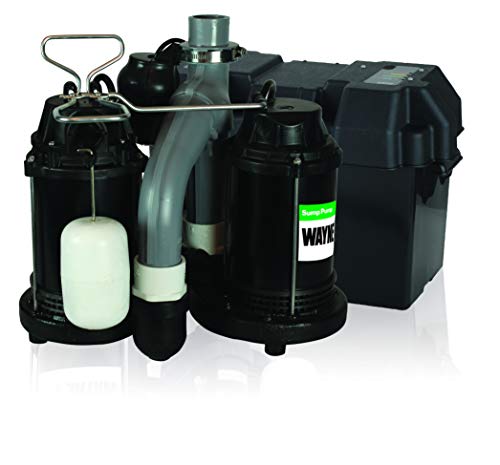
Price: Around $400
Type: Electric powered submersible pump with built-in battery back up operation
My Review: In theory, you could build your own battery back up system if you’re quite handy and know what to buy, or, you could simply purchase this system and cover all of your basis. Electricities on? The sump pump works as normal. Lose electricity? The built-in battery back up keeps that pump running for up to 10,000 gallons of pumping power.
Simply put, this is the “easy” solution to having a powerful sump pump and having it backed up. The whole system is purpose-built to work flawlessly with Waynes specific sump pump and comes already assembled and ready to roll. You’ll need a 15” basin for this massive pump, which is a little deeper than most of the other recommended pumps on this list so make sure your basin is deep enough and you have enough space around the sump pit for the battery backup system to sit.
Key Features:
- ½ HP power rating on both electrical power supply and battery back up
- Battery back up system comes already installed and supports 10,000 gallons of pumping
- Ultra-quiet performance on either power sources with thermal overload protection
10. Star 3CEH Pedestal Sump Pump

Price: Around $90
Our Review: This grout sealer by The Floor Guys comes in a one-quart container and can be used on granite, marble, and slate safely. Ideal to be used on floors and in showers, this grout dries within 5 minutes thanks to its water-based formula. This grout dries clear so it will look at if it was never applied. In addition to this, the grout sealer can prevent water and oil stains on natural stone helping it to keep its original look.
Key Features:
- ⅓ HP pedestal pump with a non-clogging multi-vane impeller
- Single phase and thermal overload protection built-in
- Capable of pumping 3000 gallons per hour at 5 feet lift rate
Buying Guide
The Job of a Sump Pump
The life of a sump pump is a rather lonely one. These little workhorses sit at the very lowest point in your home, typically hidden away by a cover, but just because you don’t often see or interact with it often doesn’t mean it isn’t an absolutely vital piece of equipment ensuring the safety and integrity of your home!
A sump pump, in short, slurps up all the water leaking into your basement. Either that water is coming up from the ground when the ground is oversaturated by rain or your basement floods through other means such as leaks or faulty drainage pipes.
Sump pumps play a massive role in protecting what’s underneath your home. If water is allowed to pool, you’ll incur moisture buildup on the walls, roof, insulation, and on anything you store in the basement. This causes mold, mildew, and can most certainly cause damage to just about everything inside and to your foundation.
Investing in a sump pump to protect your home from floods, leaks, etc is most certainly a worthwhile endeavor. If spending the money on a quality sump pump bothers you, just look at it as a type of insurance. If your drainage system that routes water away from the top and around your home becomes clogged, your basement could very quickly fill with water. A little rain may seem harmless but when all of that rain is pouring into one small space, it can add up quickly.
Cleaning and removing water damage is a homeowners nightmare. Water damage is one of the most costly and difficult undertakings any homeowner may have to face. Buying a sump pump, simply put, is worth its weight in gold. Your basement will never be the same if it fills full of water and just about anything it touches will be instantly ruined.
Water that enters your basement isn’t just clean rainwater, its full of dirt and whatever pollutants were on and around your home including fertilizers, pesticides, etc. These little machines can and will save you thousands in the event of water breaching your basement!
If you’d like to learn more, check out this Wikipedia page with information about sump pumps.
How to Identify your Need for a Sump Pump<
I’ve already mentioned before that it might actually be required by law to own and operate a sump pump depending on where your home is located. If the law isn’t enough encouragement or perhaps you aren’t bound by the U.S. Federal Clean Water Act, you may still need a sump pump, but how will you determine that? After all, these things aren’t exactly cheap and installation will require some fairly permanent changes to your basement that would be costly to reverse.
Simply put, if the area your home is located in has had a flood in the last hundred years or so, it’s probably a safe call to install a pump just in case flooding happens again. There doesn’t need to be a major environmental disaster to raise the need for a sump pump either, as only the ground directly underneath your home needs to flood to cause massive damage, which can be caused by sustained rainstorms, or unseen shifts in the ground under your home.
Walk down into your basement and take a big deep breath. Smells musty? Feels unusually humid? Have algae or mold growing on the floor and/or walls? Yeah, you need a sump pump and you need it quickly. Moisture is a silent and often overlooked force of destruction and overtime, moisture can be just as devastating as actual water buildup.
If you really can’t tell if the moisture is unusual in your basement, there’s a simple and easy test you can conduct on your own. Cut a 24 inch square of plastic wrap and tape it in place on really any given surface. After a couple of days, return to your plastic cut out and remove it from the surface, carefully inspecting it and the surface underneath for moisture. If there is anything wet at all, you likely have a water issue that requires a sump pump.
To finish up our test and make sure the moisture issue is persistent and not just a one-off oddity, you can air your basement out or use a dehumidifier to dry out the air. Once the basement is nice and dry, repeat the test above. If the results end the same, with any signs of moisture at all, it’s time for a little home improvement with a sump pump!
An ounce of prevention is worth a ton of clean up. I probably butchered that saying, but it still remains true. If you don’t have a water and/or moisture problem today, you may have one tomorrow. The ground under your home is constantly changing and even though you may not see any major differences, problems can arise quickly without much, if any, warning signs. Installing a sump pump “just in case” is never truly a bad idea and hey, it might be a nice selling point if you decide to take that property to the market.
How a Sump Pump Manages to Save the Day
There are many different designs and styles available so it’s hard to describe the exact method these little pumps use as there are so many! To help put an image in your head, the pump sits in a sump pit which allows water to easily flow inside of it and around/over your sump pump.
After water fills the sump pit and properly soaks your sump pump, a float inside the pump raises until an unacceptable level of water is reached. Once that float hits a certain threshold, the pump will activate (if it’s automatic, more on this later), and a propeller inside will begin spinning, lifting the water into a pipe and transporting the water a safe distance away from your home.
A nifty engineering marvel called a one-way check valve is used to ensure water cannot flow back into the pit after the pump sucks it up and sends it into the tube.
Sump pumps back in the day were mostly activated through physically monitoring the water level and manually turning them on, whether that be by plugging them in, flipping a switch, pressing a button, whatever. Nowadays, most quality sump pumps are capable of activating automatically.
Of course, an automatic pump is what we recommend. Imagine if you cheaped out and bought a manual one, only to incur a flood when nobody is home to turn the pump on! Automatic pumps are the way to go and really, they aren’t much more expensive than their manual counterparts anymore.
Furthermore, most automatic pumps also have a manual option if for some odd reason it’s automatic switching mechanisms fail. Speaking of switching mechanisms, your pump will most likely use either a float activator or a pressure sensor. We touched on float activators above already and a pressure sensor is pretty self-explanatory.
Pressure sensors activate the pump by sensing pressure and since water exerts far more pressure than air, it’s easy and fairly failsafe to use this method, but both work just fine.
So, what exactly is pumping the pump? Most modern sump pumps utilize what’s called a centrifugal pump. Basically, when the pump is activated, a blade that looks similar to a screw, called an impeller, begins to spin rapidly. The water is then forced to the outsides of the pipe causing excess water inside the sump pit to fill the void in the middle. The impeller begins to exert pressure as it forces more and more water to the outside area of the pipe, causing the water in the middle to be pushed upwards into a pipe that leads out of your home.
You can probably imagine how much engineering goes into these little pumps and since they’re dealing with natures most powerful force, water, they need to be strong and durable.
If you didn’t want to read my explanation or you’d prefer a visual explanation, you can just check out this quick and easy video that depicts how a sump pump works.
With that said, it’s imperative that you find and purchase a sump pump that is best suited for your individual situation that is of the highest quality from reputable manufacturers. After you’ve obtained a high-quality sump pump, your next step is installation.
Powering Your Sump Pump
Electrically powered sump pumps are by far the most commonly used and trusted devices today, however, they aren’t your only option.
Electric sump pumps are powered usually by your standard 110v electric sockets with a pretty familiar looking power cable. Keep in mind, power cables across different models may vary in length, so that’s something important to measure out and keep in mind when choosing the pump you wish to purchase.
Electric sump pumps are probably the most cost-effective, however, if the power in your home becomes incapacitated, your pump won’t run. Since sump pumps are most commonly needed in heavy storms, it’s unfortunately common to lose power when you need your sump pump the most.
A final note regarding electric sump pumps, you’ll need to consider safety. It’s easy to plug it into whatever outlet is most accessible and forget about it, but some thought should be used before doing this. A ground fault circuit interrupter (GFCI) should be used on the outlet especially because the sump pump will be sitting in water, electricities worst enemy. You wouldn’t want a damaged power cable to be sitting live submerged in water, that’s a disaster waiting to happen!
Gas powered sump pumps are always an option and work even when the power isn’t flowing. Of course, you’ll need a way to vent the fumes caused by burning gas, so you’ll most certainly need to plan for this ahead of time. Don’t forget to keep them topped off with fuel! These are available in regular petrol or diesel options.
Installing a Sump Pump
Though the role of a sump pump is incredibly important, the methods they utilize to safeguard your home isn’t very complicated! Before we get started, it’s important to note that having a professional install the unit in your home is by far the best and most recommended method. With this said, however, if you’re rather handy and have basic knowledge of plumbing and electronics, it shouldn’t be a task that is too difficult for the average DIYer.
A sump pump is positioned strategically at the lowest point possible in your basement or crawl spaces. If you don’t already have a sump pump pit, you’ll need to dig one out. A sump pump pit is typically only going to be a few feet and your most challenging portion of this task will be to remove the concrete where you’re digging your pit.
Since sump pumps come in different designs, sizes, power levels, and even have different mechanisms for slurping up and removing water, you’ll need to consult with its manual for the exact depth of your sump pit. Usually, expect to have a hole that is around 25 inches deep and 20 inches wide.
After you’ve scoped out where water will most likely congregate and you’ve dug a big ugly hole in your basement, you’ll want to insert a sump pump liner (discussed later) into the hole and then fill the space around that liner with coarse gravel. The bottom of the pit needs to have room to breathe and the best way to do that is to ensure there are roughly six inches of gravel sitting there.
Without using pipe putty as it can clog and damage the pumps internals if it falls inside, firmly attaches the discharge pipe to your sump pump. Make sure it stands upright, stands sturdy, and ensure its leveled out.
After you’ve got your discharge pipe in place, you’ll need a drain pipe. Most people use a polyvinyl chloride (PVC) pipe that is 12 inches in length. Drill a hole and attach the discharge pipe. Use pipe cement to ensure everything stays together firmly.
Something you’ll want to look out for is what’s called an “air lock”. To avoid this, puncture a small vent hole in your discharge pipe above where water would ever be able to reach but to a point where water can run out of the hole and back into the sump pit.
Caulk up everything ensuring a watertight seal and fasten some supports for all of your pipework. This can be as easy as using wall mounts or joists.
Sump Pump Liner
The sump pump liner, also sometimes referred to as a sump basin, is a round plastic container roughly the size of a five-gallon bucket installed in the sump pump pit. The liner serves as the receptacle to collect water for the sump pump that will be removed. The liner will have small perforations throughout its construction that will allow water to flow into the pit and around the sump pump while also ensuring that large debris is filtered out.
Some top sump pump liners are:
AK Industries AKP35025 18″ x 22″ Poly Pro Basin
Little Giant Basin Crawl Space 18 Gallon Capacity
Emergency Backup Sump Pump
It’s pretty likely to assume that you either have or will purchase an electrically powered sump pump. That’s great and I do highly recommend that, but we’ve already mentioned the possibility of your sump pump becoming incapacitated due to a power outage. Sump pumps can also fail!
We’ll talk about maintenance and what you can do to keep them running for years to come, but all electric devices are prone to failure eventually even if you do maintain them flawlessly.
Even worse, you could purchase a sump pump that usually has the power to defend your home but without warning, you’ve got sustained torrential downpours and that little guy, despite pumping his heart out, eventually cannot keep up and becomes overrun.
If you truly want to keep your home safe from an all-out water invasion under any circumstances, you may want to consider a backup sump pump. You could just install two, that’s fine and probably offers a pretty high level of preparedness. If you choose this route, I highly recommend choosing two methods of power sources. If you use two electric powered sump pumps, plug them in on different circuits.
You can also use a battery backup sump pump. These are powered using a DC or AC/DC rechargeable battery and offer you protection for several hours in the case of a power outage or your current system needing a little extra support.
We spoke earlier about gas powered sump pumps. These can be used as a pretty solid back up option and are available in both gas and diesel options. Just make sure you actually have gas on hand to power them!
Another option is to use a water powered sump pump. It sounds kind of odd, right? Using water to pump water away. Yeah, definitely odd, but they are effective as a backup, and a back up only. These pumps are connected to your water connection and use the pressure of constant water flow to help operate the pumps functions. The same amount of water is required from your water connection to remove the invading water, so these obviously aren’t a viable main pump option but are usable in the case of a power outage or primary pump failure.
If Murphy’s law comes into full effect and everything seems lost, you might need to buck up and start bucketing water out of your basement. You can also use manually operated water pumps. I recommend a little extra forearm training at the gym in preparation, though, as these can be quite taxing over a long period of time!
Speaking of emergencies, make sure you have a battery-backed alarm system that will alert you to unusual or nonexistent sump pump activity. Some of these systems are simply a loud alarm and others, more up with the times, can send you cell phone notifications and even contact your home security company on your behalf.
A little nifty device that I found works well is the PumpSpy Wi-Fi Sump Pump Smart Outlet. This little bugger can connect to the WiFi in your home and deliver notifications via an app to your smartphone for high water levels, abnormal voltage, pump malfunctions, etc.
Sump Pump Power
I mentioned in the last section sump pumps being overrun with unusual amounts of water. Not all sump pumps are created equally and the power ratings vary drastically.
When shopping, you’ll likely notice a horsepower rating in the heading or description of just about every offering on the market. The horsepower (HP) rating is incredibly important and will determine how powerful your sump pump is. The most common power ratings are one-quarter horsepower to one-half horsepower.
Of course, if minor moisture problems are the primary cause for concern, you likely won’t need a big and beefy sump pump. If you think you’re prone to some serious water flow, though, you may consider more powerful options all the way up to 2HP.
Sump Pump Causes of Death
Sump pumps have some pretty incredible life expectancies that sometimes range all the way up to ten years! Unfortunately, it’s difficult to tell exactly when your sump pump is lying on its death bed. Sometimes, you can call a professional to inspect your unit and they should be able to give you a decent health report.
Old age wear and tear primarily comes down to how often it has to activate, how long it needs to run to complete its job, the integrity of the power source, and the overall build quality. A sump pump that lasts for 10 years doesn’t mean it gave 10 years of service. Perhaps it only activated once a year, that’s not very good longevity! At the end of the day, the more you spend, the more likely it is to have a longer lasting sump pump, as with pretty much all things in life!
If the sump pump is installed incorrectly and begins to run without any water being present at all, it’ll burn up and die rather quickly. This can also occur from a clogged drainage system or no drainage system at all! If the pit is completely water free, it’s a good idea to disconnect the pump to ensure it doesn’t run dry.
If your sump pump started out running smooth and quiet and now sounds horrendously awful with rattles, thuds, grinding, gurgling, or whatever else odd sounds these little machines can deliver, you should shut it off immediately and have it inspected. An odd sound doesn’t always mean the pump is toast if you can shut it off quickly enough, but it can be a sure sign something requires professional attention.
The switches that we discussed before are prone to malfunctioning and can cause overuse or dry running. Check float switches often for clogs or debris that could be tangled up inside, not allowing the float to rise or drop back down properly.
Check valves are also a potential culprit in abnormal sump pump activity. These can break, causing the water your sump pump is pumping upwards to immediately fall right back into the pit, causing the pump to pump the same water continuously.
You may have an unusual water table or even an underground spring that you didn’t know of before installing. If your sump pump has to work incredibly hard even without inclement weather, it’s pretty likely that a bad storm will overwork your pump quickly. You may have to move your sump pump station or install a more powerful pump. Usually, if you have a high water table under your home, it’s best to let a professional assess the situation and install the pump.
Sump Pump Maintenance
You should be regularly checking your sump pump, perhaps, at least once a month. I can’t remember to check my sump pump regularly so I actually set alarms on my phone so that I don’t forget!
Your sump pump is likely pretty powerful and while it’s working hard to rid your basement of water, it can cause minor vibrations that, over time, can actually change its position in your sump pit. You’ll need to regularly make sure that sucker is in its proper place and it still aligned properly with the rest of its system.
If you’ve experienced an extended dry season and you haven’t heard your pump run for a while, you can simply pour a bucket of water into the pit and ensure everything sounds good and the system works properly.
Most sump pumps will have a grate on the bottom or the side where the water enters the pipe. You’ll need to clean that grate often and ensure it’s not packed with debris that restricts the flow of water. This may require removing the sump pump from the pit, so make sure you unplug it or cut its power source before doing so.
Regularly check the exit of the system and make sure the water flows away from your home and exceeds 20 feet of distance from your foundation. The pipes outside can become dislodged, damaged, clogged, moved, or aliens could abduct them, so keep an eye on your plumbing!
We spoke about making a vent hole earlier on in this guide. Make sure that vent hole stays venting!
Conclusion
That guide was a doozy and I think most of you probably just want two questions answered: What is the best Sump Pump and where can I buy it for a good deal?
Remember, though, it’s incredibly important to plan ahead and really consider which pump is best for your specific situation. You can learn more about the different types of sump pumps here. I can’t possibly know where your home is located, how much water you have an issue with, how large your basement is, what laws apply in your area, or what pump is best for you, so you’ll need to do some planning before you buy!
Wayne Pumps has an excellent Solution Center page on their website. Check out their page on Choosing the Right Sump Pump if you’re looking for additional help.
The above recommendations though some of my favorite pumps that have a good track record and are available for killer deals. If you have any questions, make sure to leave it in the comments below!

Hello, my name is Chris and I was born and raised in Western Pennsylvania. I’m an engineer with experience in medical technology, steel and materials, and nuclear power industries. I have been with my current employer for more than 5 years developing digital control systems for nuclear power plants.
I’m also a homeowner with a growing range of home renovation experience. My goal is to take all my technical knowledge and first-hand experience and translate it into high-quality content to support all of your home guide needs. Whether it be step-by-step guides, technical consultation, or product reviews, my aim is to make all your home projects a great success!
